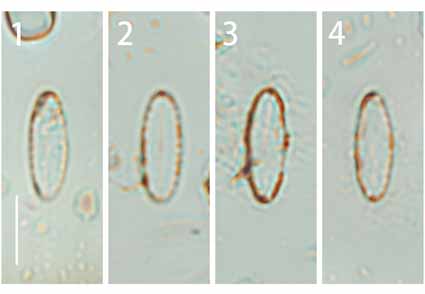Abstract
This study describes two new species of Plagiostriata: P. xiapuensis sp. nov. and P. pingtanensis sp. nov., both collected in the intertidal zone of Fujian Province, China. This is the first record of species in the genus Plagiostriata in China. The morphological characteristics of the two new species are discussed in detail using light and scanning electron microscopy. Plagiostriata xiapuensis sp. nov. is characterized by its lower stria density and simple volae-covered areolae compared to the higher stria density, small and complex volae–covered areolae in P. pingtanensis sp. nov. The morphological characteristics of these two species significantly differ from those of P. goreensis and P. baltica in sternum and areolae features, which is also discussed herein.
References
Chudaev, D., Jüttner, I. & Van de Vijver, B. (2021) Fragilaria irregularis sp. nov., a new araphid species (Fragilariaceae, Bacillariophyta) from the River Adegoy, Krasnodar Territory, Russia. Phytotaxa 508: 221–228. https://doi.org/10.11646/phytotaxa.508.2.11
Cox, E.J. & Ross, R. (1981) The striae of pennate diatoms. In: Ross, R. (Ed.) Proceedings of the sixth symposium on recent and fossil diatoms. Otto Koeltz Science Publishers, Koenigstein, pp. 267–278.
Cox, E.J. (1999) Studies on the diatom genus Navicula Bory. VIII. Variation in valve morphology in relation to the generic diagnosis based on Navicula tripunctata (O. F. Muller) Bory. Diatom Research 14: 207–237. https://doi.org/10.1080/0269249X.1999.9705467
Kociolek, J.P., Kulikovskiy, M., Genkal, S. & Kuznetsova, I. (2017) Morphological investigation and transfer of Naviculadicta parasemen Lange-Bertalot to the genus Rexlowea Kociolek & Thomas. Diatom Research 32: 477–481. https://doi.org/10.1080/0269249X.2017.1403377
Krammer, K. & Lange-Bertalot, H. (1986) Bacillariophyceae, Teil 1: Naviculaceae, In: Ettl, H., Gerloff, J., Heynig, H. & Mollenhauer, D. (Eds.) Sü?wasserflora von Mitteleuropa. 2/1. Gustav Fisher Verlag, Stuttgart, Jena, 876 pp.
Lange–Bertalot, H. (2001) Navicula sensu stricto. 10 genera separated from Navicula sensu lato. Frustulia. In: Lange-Bertalot, H. (Ed.) Diatoms of Europe 2. A.R.G. Gantner Verlag K.G., Ruggell, 526 pp.
Li, C.L., Witkowski, A., Ashworth, M.P., D?bek, P., Sato, S., Zg?obicka, I., Witak, M., Khim, J.S. & Kwon, C.J. (2018) The morphology and molecular phylogenetics of some marine diatom taxa within the Fragilariaceae, including twenty undescribed species and their relationship to Nanofrustulum, Opephora and Pseudostaurosira. Phytotaxa 355: 1–104. https://doi.org/10.11646/phytotaxa.355.1.1
Marquardt, G.C., Bicudo, D.C., Bicudo, C.E.M., Ledru, M.P., Ector, L. & Wetzel, C.E. (2021) Pseudostaurosira crateri sp. nov. (Fragilariaceae, Bacillariophyta), a new small araphid, fossil diatom species from the Pleistocene (Atlantic Forest, Brazil). Phytotaxa 496: 105–120. https://doi.org/10.11646/phytotaxa.496.2.1
Medlin, L.K. & Desdevises, Y. (2016) Phylogeny of ‘Araphid’ diatoms inferred from SSU & LSU rDNA, rbcL & psbA sequences. Vie et Milieu 66 (2): 129–154.
National Marine Information Center (2018) Tide Table Query, China Maritime Service Network. Available from: https://www.cnss.com.cn/tide/ (accessed 19 May 2018)
Ross, R., Cox, E.J., Karayeva, N.I., Mann, D.G., Paddock, T.B.B., Simonsen, R. & Sims, P.A. (1979) An amended terminology for the siliceous components of the diatom cell. Nova Hedwigia Beiheft 64: 511–533.
Round, F.E., Crawford, R.M. & Mann, D.G. (1990) The diatoms. Biology and morphology of the genera. Cambridge University Press, Cambridge, 747 pp.
Sato, S., Matsumoto, S. & Medlin, L.K. (2009) Fine structure and 18S rDNA phylogeny of a marine araphid pennate diatom Plagiostriata goreensis gen. et sp. nov. (Bacillariophyta). Phycological Research 57: 25–35. https://doi.org/10.1111/j.1440-1835.2008.00518.x
Sato, S., Nanjappa, D., Dorrell, R.G., Vieira, F., Kazamia, E., Tirichine, L., Veluchamy, A., Heilig, R., Aury, J.M. & Jaillon, O. (2020) Genome-enabled phylogenetic and functional reconstruction of an araphid pennate diatom Plagiostriata sp. CCMP470, previously assigned as a radial centric diatom, and its bacterial commensal. Scientific Reports 10: 9449. https://doi.org/10.1038/s41598-020-65941-x
Vijver, B.V.D., Joachim Hürlimann, Williams, D.M., Levkov, Z., Wetzel, C.E. & Ector, L. (2021) Fragilaria subrecapitellata (Fragilariaceae, Bacillariophyta), a new diatom species from Switzerland. Diatom Research 36: 119–131. https://doi.org/10.1080/0269249X.2021.1942221


